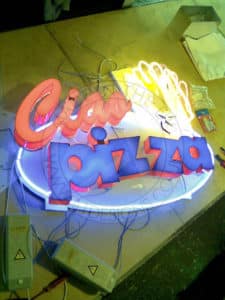
NEON: There is only one type of neon. Hand made from straight lengths of glass that are heated over a flame and blown into while being bent to shape. It’s not made by a machine or mass produced… it’s an art form.
The very first demonstration of a neon sign in a modern form was in December 1910, by a man called Georges Claude at the Paris Motor Show, who displayed two 12-metre-long tubes filled with the gas. From that point, the world has been fascinated with neon signs and its popularity and uses has evolved over the many years.
The combination of their striking appearance, nostalgic appeal, and versatility makes neon signs a popular choice for businesses, events, and individuals looking to make a statement.
At A1DeSIGNS, we have over 120 years of experience in making neon signs and are always training the next generation in the art of glass bending and sign making to ensure that quality products are sent out for years to come.
We’re frequently being asked all sorts of questions about neon signs and here are some answers to the most popular queries around neon.
Are neon signs expensive?
The cost can vary depending on factors like size, complexity, and where you’re buying them.
Despite being a completely hand-made product, neon signs remain a cost-effective option in today’s market. Many people find the unique and vibrant look of neon signs worth the investment.
Are neon signs expensive to run?
No, the cost is low – less than your washing machine for the same amount of time, for example.
When looking at the running cost of neon, you are needing to work out the kWh. This is done by working out the wattage (real wattage) being used by the transformer and converting that into kilowatts. Then multiply that figure by the number of hours the transformer will be running. This is then multiplied by your electricity cost per kWh.
A cost of neon guide
If we take our 8kv/18mA wire wound transformer running at 95watts of power. The sign it powered was running for 10 hours a day for every single day of the year.
- 95 watts /1000 = 0.095kWh
- 0.095kWh x 10 hours per day = 0.950kWh
- 0.950kWh x 365 days = 346.75kWh over the year at 10 hours per day.
- 346.75kWh is then multiplied by the current cost for your electricity per
- kWh. The current average at the time of writing this is 14.37p/kWh.
- 346.75 x 14.37p = 4982.78p /100 = £49.82 for the year.
Are neon signs dangerous?
When installed correctly, they are no more dangerous than other household appliances.
Here’s why?
When installed correctly the voltage from a neon sign is insulated from being touched. If contact is made with a live connection, transformers generally have protection devices that switch the unit off.
Neon is generally classed as high voltage (above 990v), but the current is low on a neon transformer, in the milliamp (mA) range usually around 18-20mA. The socket in your house although only 240v can be as high as 30amps 30,000mA of current.
Voltage makes less of a difference in the case of an electric shock, whereas current makes a massive difference, for example static electricity is in the range of 25,000 – 35,000 Volts, but the current (measured in mJoules) is extremely low and not constant.
Current has the following effect on the body At 20-75mA of current someone would receive a painful jolt and loss of muscle control.
At 75-100mA of current, ventricular fibrillation of the heart can occur (uncoordinated twitching of ventricles).
At 100-200mA of current, ventricular fibrillation occurs, often resulting in death. At over 200mA of current, severe burns and severe muscle contractions occur and internal organs can be damaged, and the heart can stop due to chest muscles applying pressure. However, this clamping effect can prevent ventricular fibrillation, greatly improving the chances of survival if the victim is removed from the electrical circuit.
Are neon signs tacky?
Ultimately, whether a neon sign is considered tacky or not is subjective, and opinions on their aesthetic appeal can vary widely.
However, neon signage is on an upwards turn in terms of popularity with massive increase in demand for neon signs for bars, clubs and restaurants.
Once again being used to attract the crowds, neon is working its magic and becoming the go to for external signs. Some are taking the trend to the next level by installing these brilliant signs inside to create a retro feel.
Are neon signs plasma?
Neon signs don’t use plasma as the primary means of producing light, but they do involve a similar principle.
Inside a neon sign, there are glass tubes filled with either neon or other gases like argon, xenon, or krypton. When an electrical current is passed through these gases, it ionizes them, causing them to emit light. This process is similar to how plasma lights work, where gas is ionized to produce light.
However, neon signs specifically rely on the ionization of gases within glass tubes to create their characteristic glow, rather than generating plasma in the traditional sense.
Can neon signs be repaired?
Yes. Neon signs can be repaired.
Some common repairs we deal with include replacing broken glass tubes, fixing broken wires or connections, and replacing failing transformers or power supplies.
If your sign stops working for any reason, turn it off then on again. If this does not correct the issue, turn it off and leave it off, then contact us so we can assist with fixing it.
It is important to only trust trained professionals with repairing neon signs, as they can be dangerous to work with and require specialised knowledge and tools. * If you cannot bring your broken sign to us – we can come and investigate the fault and more-often-than not make any subsequent repairs on site.

Can neon signs be used outdoors?
This is quite an open question with various different points to consider, based on your specific needs. However, the short answer is yes, neon signs can be used outside as long as you have been provided with the right transformer. All neon glass is suitable for use outside, if you live in a particularly cold area (North Scotland for example) then you may need your tubes pumped with a certain mixture of gas, but generally the only thing deciding the sign’s use is the transformer it comes with.
Can neon signs be refilled?
Yes, neon signs can be refilled, but the process is quite complex and requires specialized equipment and expertise.
When a neon sign is made, the glass tubes are filled with gases like neon, argon, xenon, or krypton, and then sealed. Over time, due to factors like gas leakage or degradation, the gases inside the tubes can diminish, causing the sign to lose its brightness or stop working altogether.
To refill a neon sign, the sign must first be disassembled, and the old gas removed from the tubes. Then, the tubes are vacuumed to remove any impurities. Next, the desired gas is introduced into the tubes at the correct pressure and purity level. Finally, the tubes are sealed again to prevent gas leakage.
Refilling a neon sign requires specialized knowledge and equipment, so it’s essential to have the process performed by professionals who are experienced in working with neon signs. Additionally, not all neon signs may be refillable, depending on factors like the condition of the tubes and the type of gases used.
Can neon signs freeze?
The gas inside a Neon sign will not freeze. If water is on the outside of a tube and is exposed to a cold enough temperature, then this can freeze and can potentially damage / break the sign.
However, provided a sign is kept running it should generate enough heat at the electrodes to keep the gas ignited and should help prevent the tubes from becoming cold enough to allow ice to form.